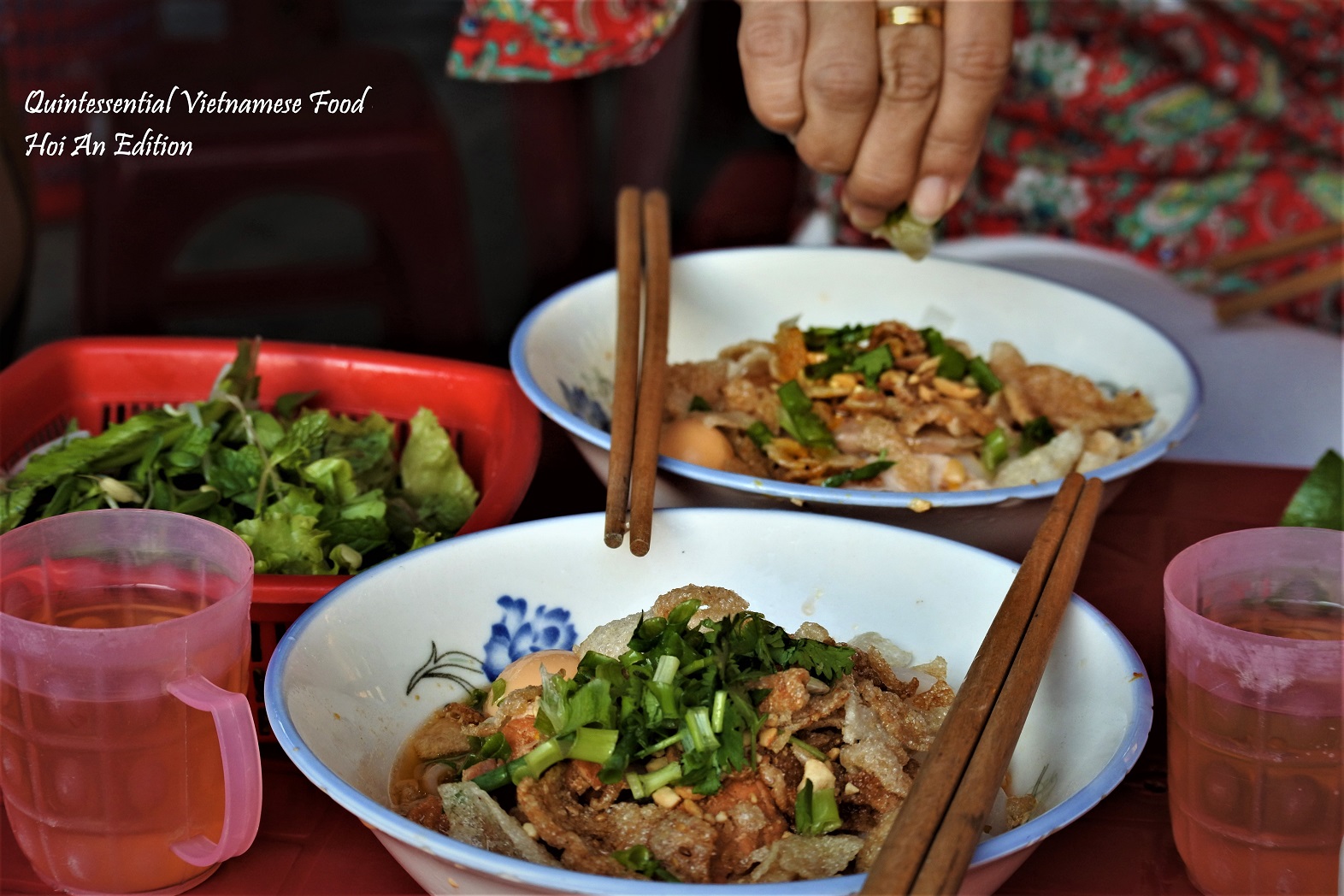
Hoi An is famous for its well-preserved Ancient Town. Dotted with old buildings and bridges of various eras and styles, the architecture was heavily influenced by a mixture of cultures such as the Chinese, Japanese and French, reflecting its glorious past as a prominent port city in Vietnam.
Apart from its mesmerising architecture, I have discovered that Hoi An has its fair share of delicious good food. The taste of the dishes are unique to Quang Nam province and are distinctive from the food in other parts of Vietnam such Hanoi and Ho Chi Minh. Ranging from street food to restaurant-quality food, here are some of my gastronomic highlights of the trip:
1.Cao Lầu (BBQ pork rice noodles)

Cao lầu is a quintessential Hoi An-originated dish and is largely popular in the central Vietnam’s Quang Nam province.
Why is it called Cao lầu?
This dish has its roots in the Canton region of mainland China and was introduced by Cantonese traders and merchants when they sailed down south to Hoi An for business. Cao lầu rhymes with 高楼 which refers to tall buildings in Chinese (or whatever Chinese dialect it’s originated from).
In the past, shop houses in Hoi An are usually two-storey high, the first storey is mainly for trade and business, while the second storey is mainly for restaurant businesses. So, if you want to have a bowl of Cao lầu, you would have to go up to the second storey of the shop houses to have it! What an interesting backstory and name for a noodle dish!
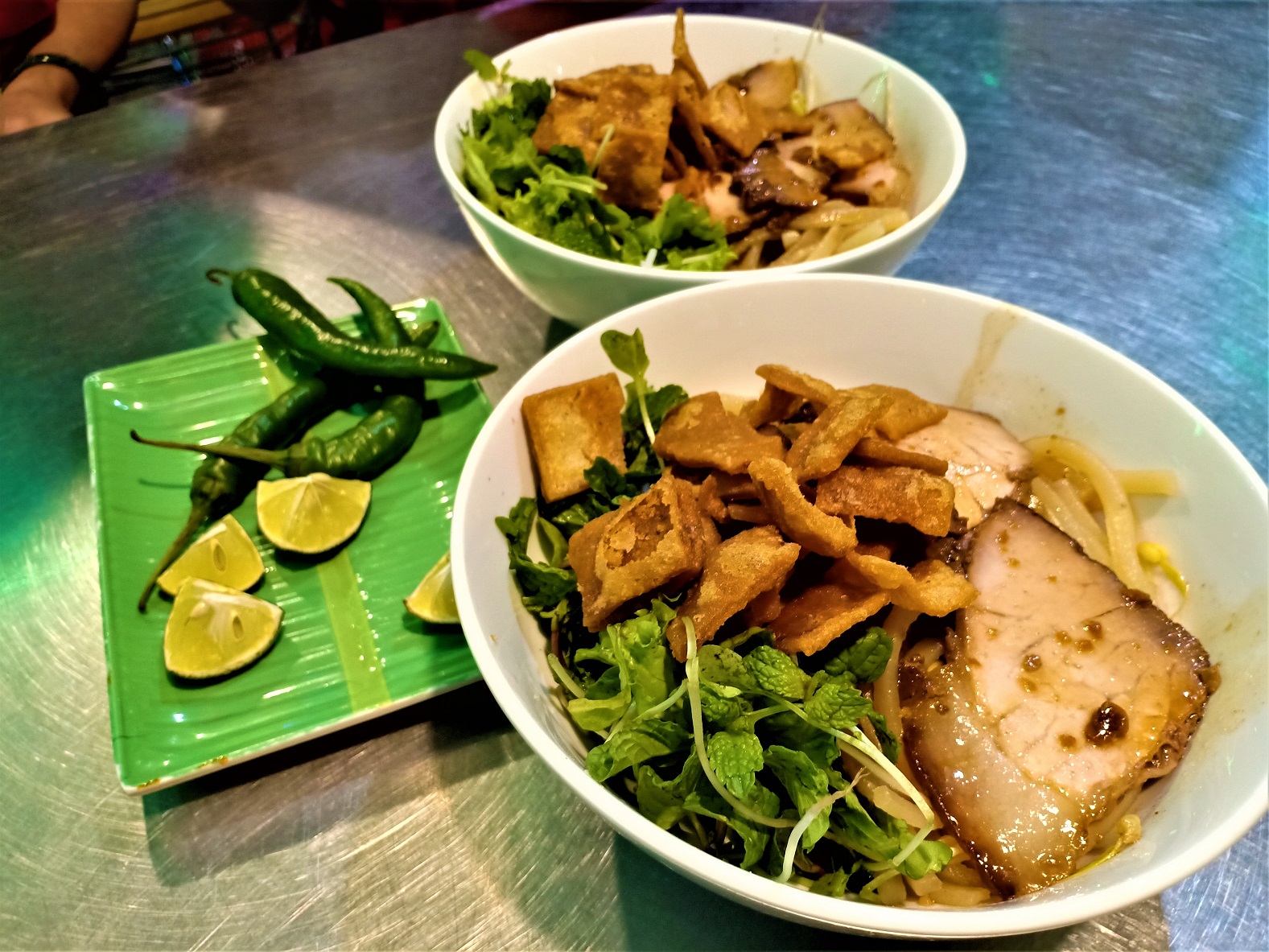
So, what’s so special about the dish and what’s in it? As you could probably tell from the photos above, Cao lầu typically consists of rice noodles, Vietnamese-style BBQ pork belly or xa xiu in Vietnamese (or char siu in Cantonese), greens, herbs, bean sprouts and topped with deep fried rice crackers.
The noodles are thick and have a springy and chewy texture, which reminded me of Japanese udon noodles, with the exception that these noodles are gluten-free as they made from rice. Interestingly, I also found out that the crackers that they use to top the dish with are actually made from the same rice noodles but were cut into squares and deep fried until crispy!
The pork had a good balance of meat and fat which melted in my mouth after a few bites. The combination of the rice noodles, mint, greens and the pork gives the dish a very refreshing taste.
Sweet and savoury from the BBQ pork, followed by crispiness of the crackers and crunchiness from the bean sprouts which add another dimension of texture to the dish, next you have a slight tanginess from the lime pulps and the cool, refreshing flavours from the mint and other herbs, which cut through the greasiness of the BBQ pork.
Where: Khong Gian Xanh, 687 Hai Ba Trung St., Hoi An.
How much: Around 40,000VND per bowl.

2. Mì Quảng or Mỳ Quảng (Quang Noodles)
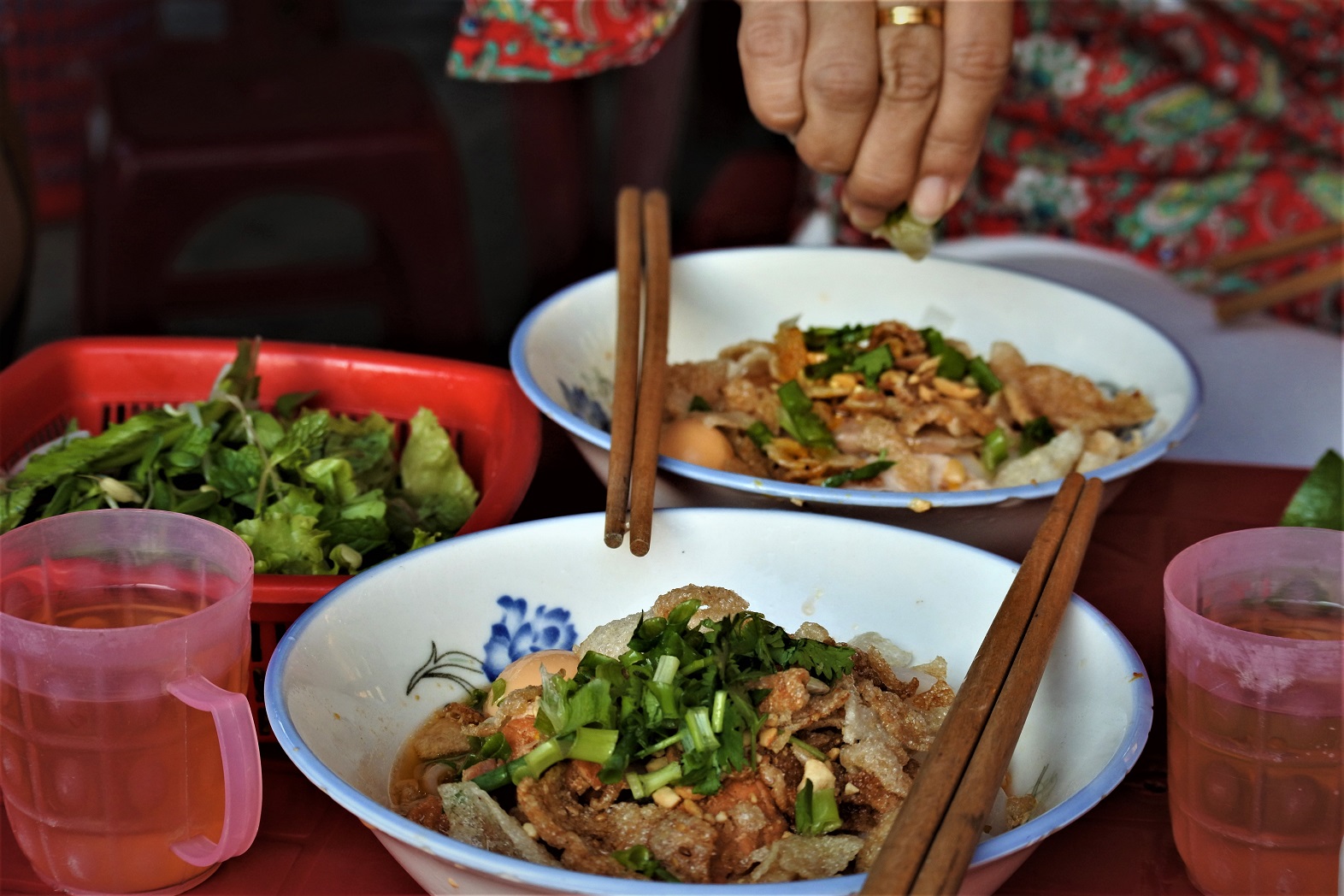
As its name suggests, Mì Quảng originates from the Quảng Nam province in Central Vietnam. It’s a versatile dish which you could have it for breakfast, lunch or dinner.
You might be wondering, what is its difference from Pho or other rice noodle dishes? The secret lies with its broth and toppings.
The broth gains its main flavour profile from pig’s bones or sometimes chicken, onions and garlic. Another interesting characteristic to note about Mì Quảng is its use of tomatoes and sometimes pineapples in its broth which renders the aroma and the sweet and sour taste that are unique to this noodle dish. The broth is also infused with turmeric and lastly flavoured with fish sauce.
The appearance of the noodles is also different from the other types of Vietnamese noodles – they are thicker, flatter and are usually coloured with turmeric to give its distinctive yellowish tinge.
The noodle dish is usually served with a small amount of broth, just enough to cover the noodles. The toppings usually consist of crushed toasted peanuts, fried shallots, fried rice crackers, few pieces of sliced meat (chicken or pork), sometimes quail eggs, sometimes fried spring rolls; and last but not least a generous serving of herbs and greens, a fixture in Vietnamese cuisine.
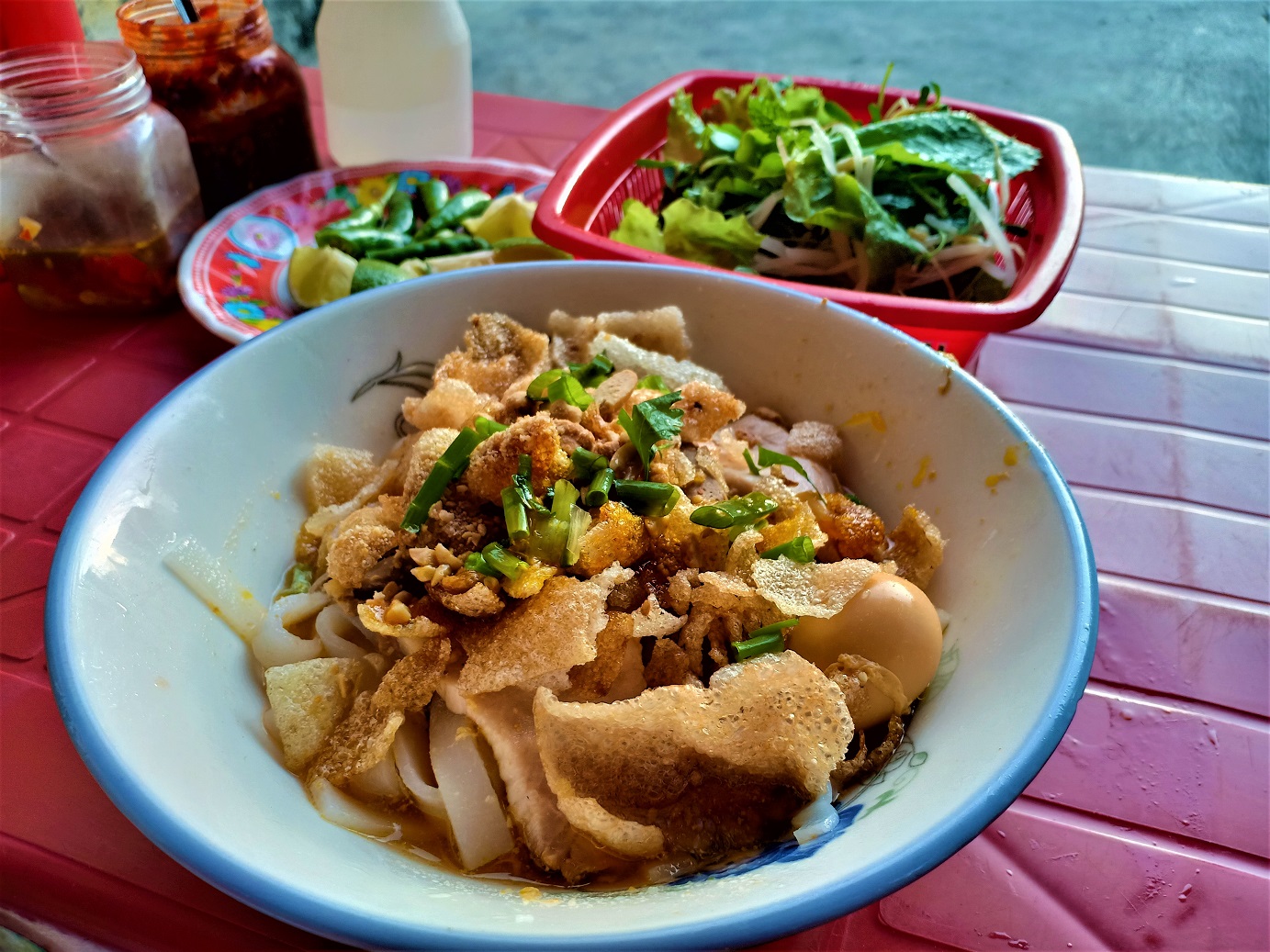
Just by looking at the photo, I can’t wait to dig in!

A word of caution, when dining at road side stalls where you eat squatting down on kindergarten-sized stools and tables, prices are usually not labelled and there are no menus (in English) in most cases.
The first time we dined at this hole-in-the-wall road side stall (see picture above), we blindly ordered two bowls of Mì Quảng without asking for the price first. The lady charged us 40,000VND for each bowl, which I think it’s overpriced (by Vietnamese standards) for such a small portion of noodles which only had two measly quail eggs, few crackers and a handful of noodles in it.
We later on observed that another local only paid 20,000VND for a bowl of noodles, we then immediately knew that we got ripped off. Even though it was not a huge amount of money, we couldn’t help but to feel cheated due to her dishonesty and practice of double standards.
It’s definitely a very common occurrence to get scammed or ripped off by certain unscrupulous vendors or stall owners in Vietnam. My advice is to stay cautious and observe what the locals are paying.
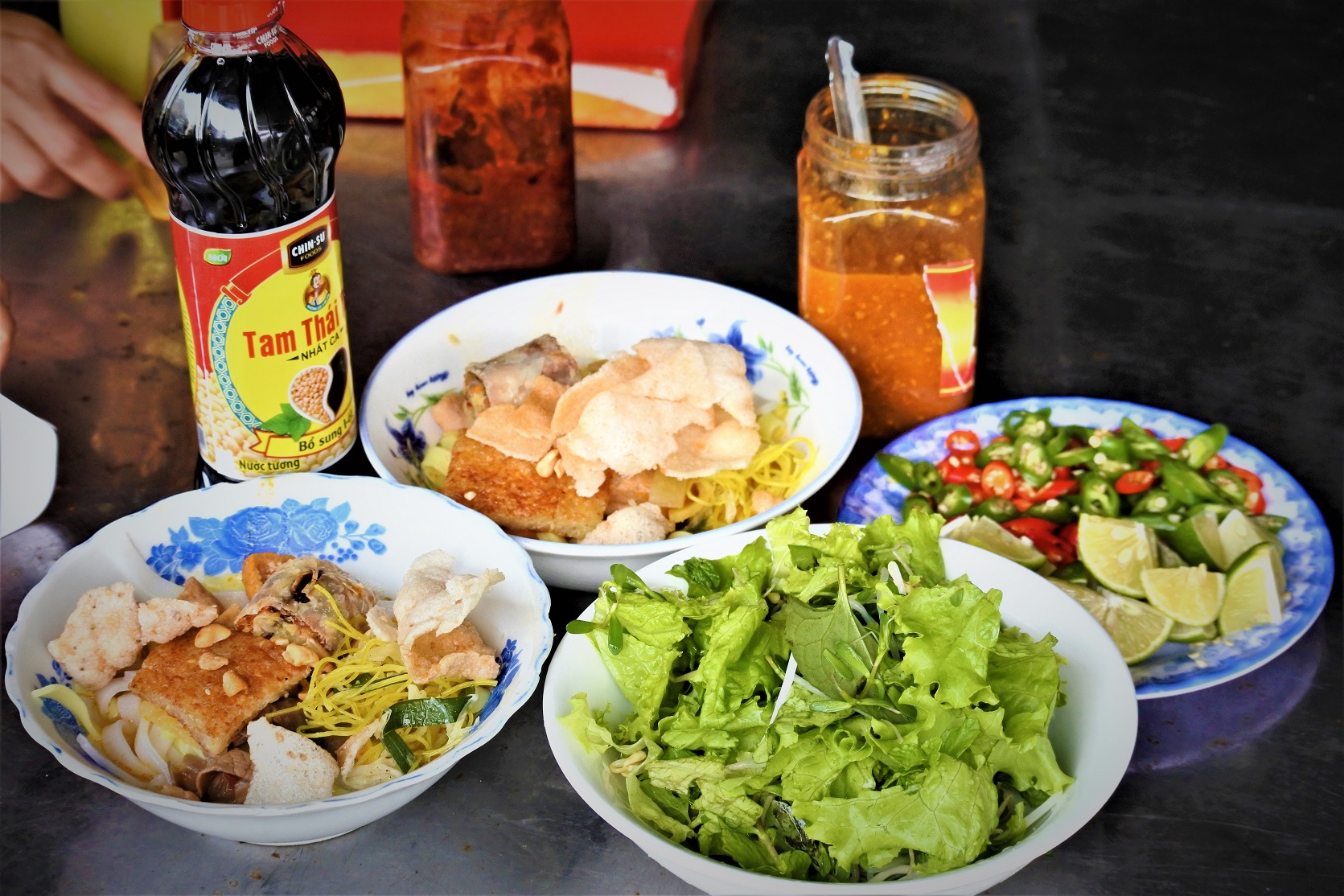
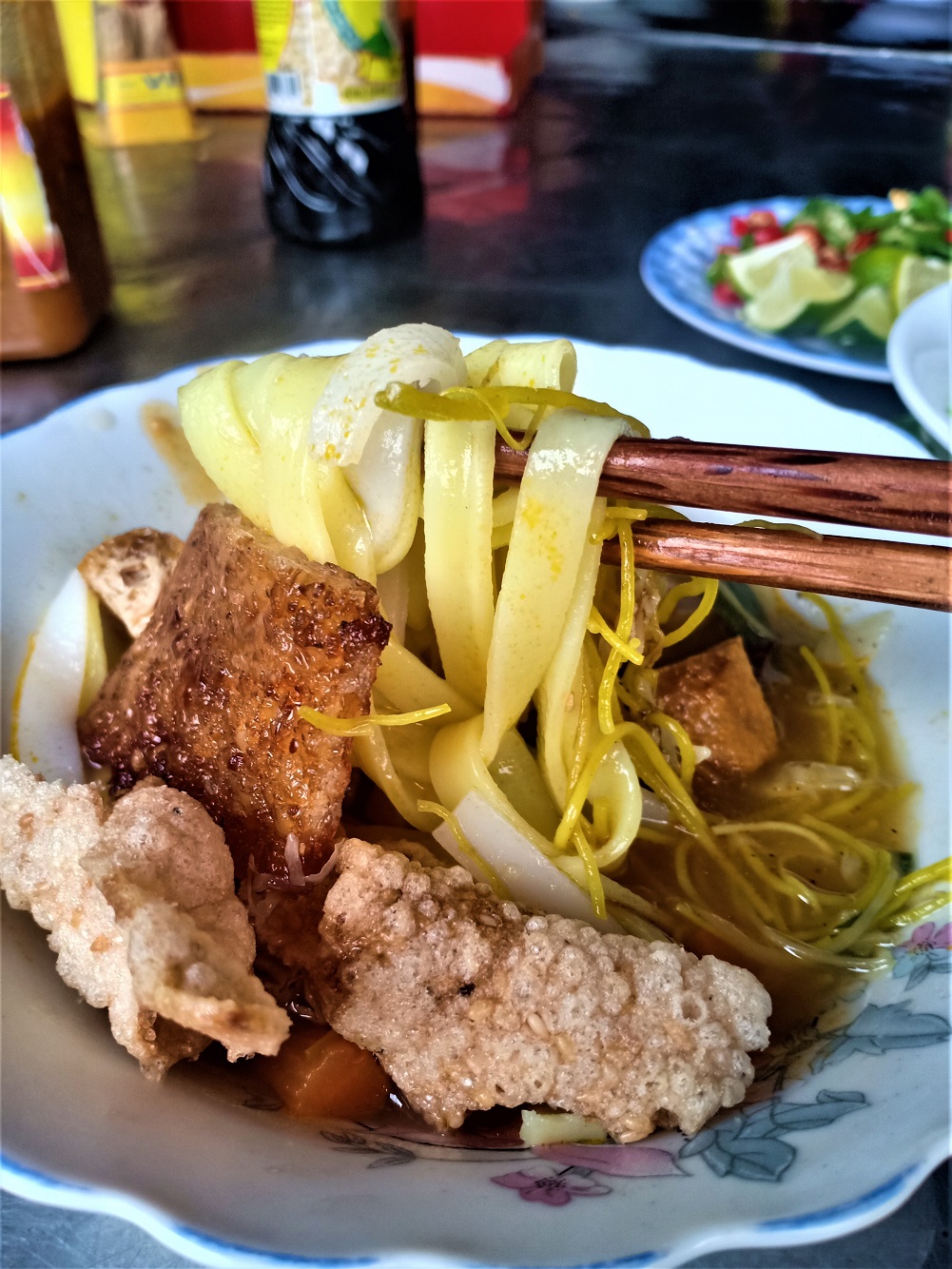
Where: Street food stall close to where the Hoi An night market is, right opposite Nha hang Khoai Tay.
How much: Ranging from 20,000VND – 40,000VND
3. Bánh Bột Lọc (“Crystal” Tapioca Dumplings)
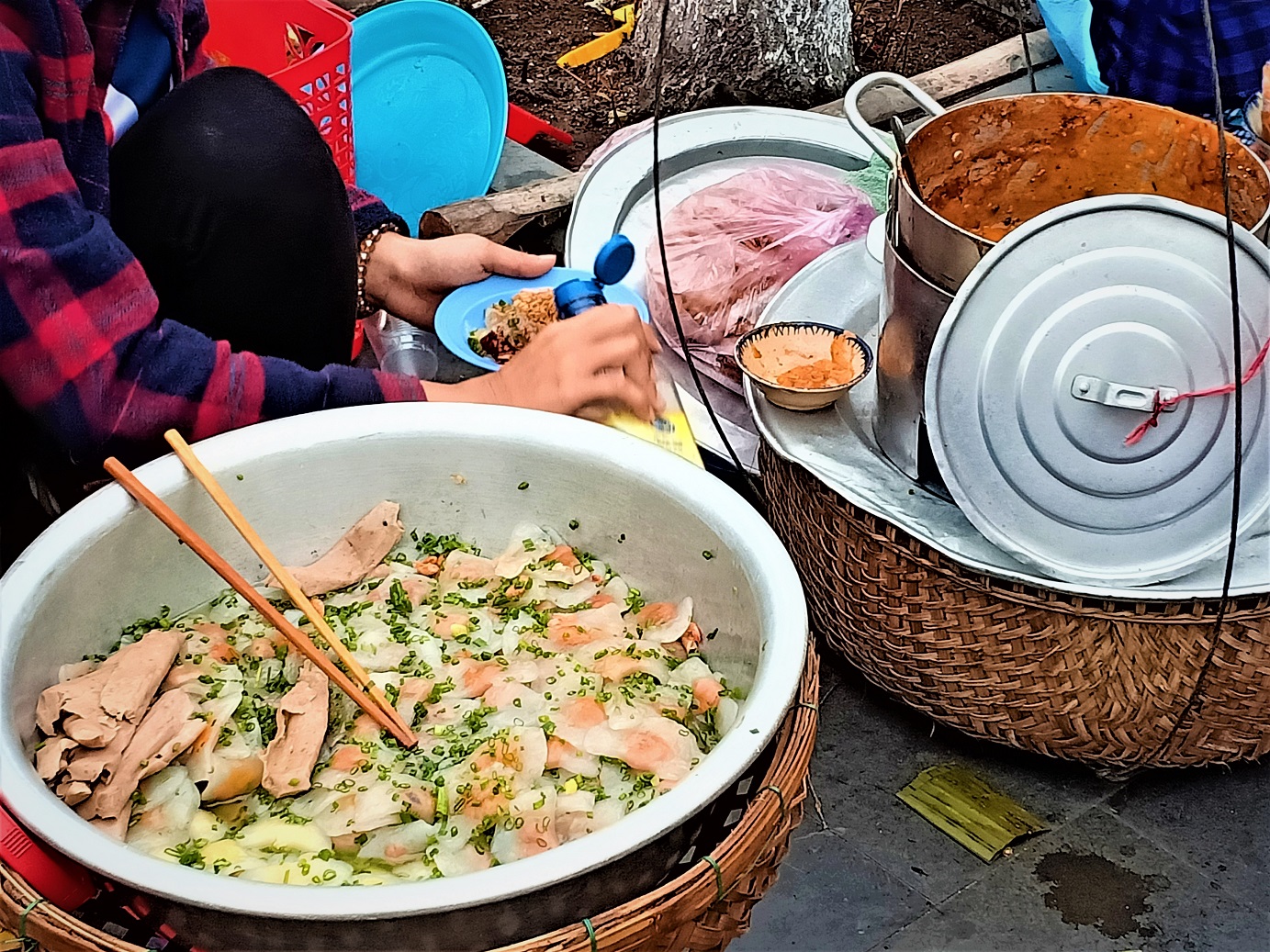
Chewy and transparent, Bánh bột lọc are great as snacks or appetisers. Known to be originated from the Imperial city of Hue, its Vietnamese name literally means clear flour cake.
The translucent skin is usually from tapioca starch and the dumplings are usually filled with shrimp and pork. The dipping sauce complements well with the dumplings, giving them extra kick of sweetness and savouriness to the otherwise bland and tasteless tapioca skin.
It sort of reminded me of a Cantonese dim sum dish – crystal dumpling or 水晶饺, but the tastes between the two are quite different. Bánh bột lọc is more flavourful as it is doused in sweetened fish sauce, while the Cantonese crystal dumpling is served dry without any sauce.
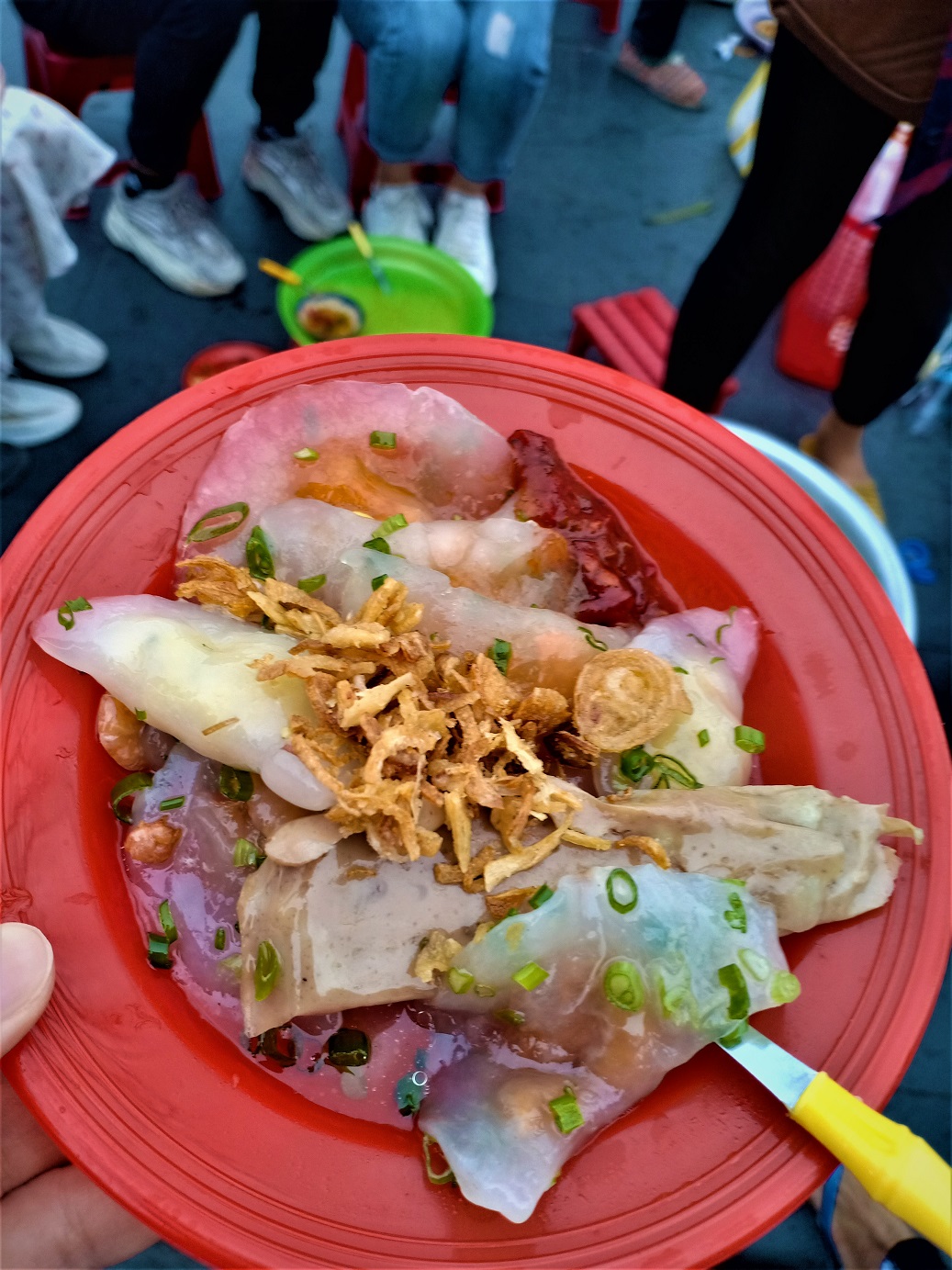

Where: Right next to the river along Bach Dang street, right opposite to the crowded grilled pork established “Anh”.
How much: 20,000VND – 30,000VND per plate
4. Bánh Bèo (Tiny Steamed Savoury Rice Cakes)
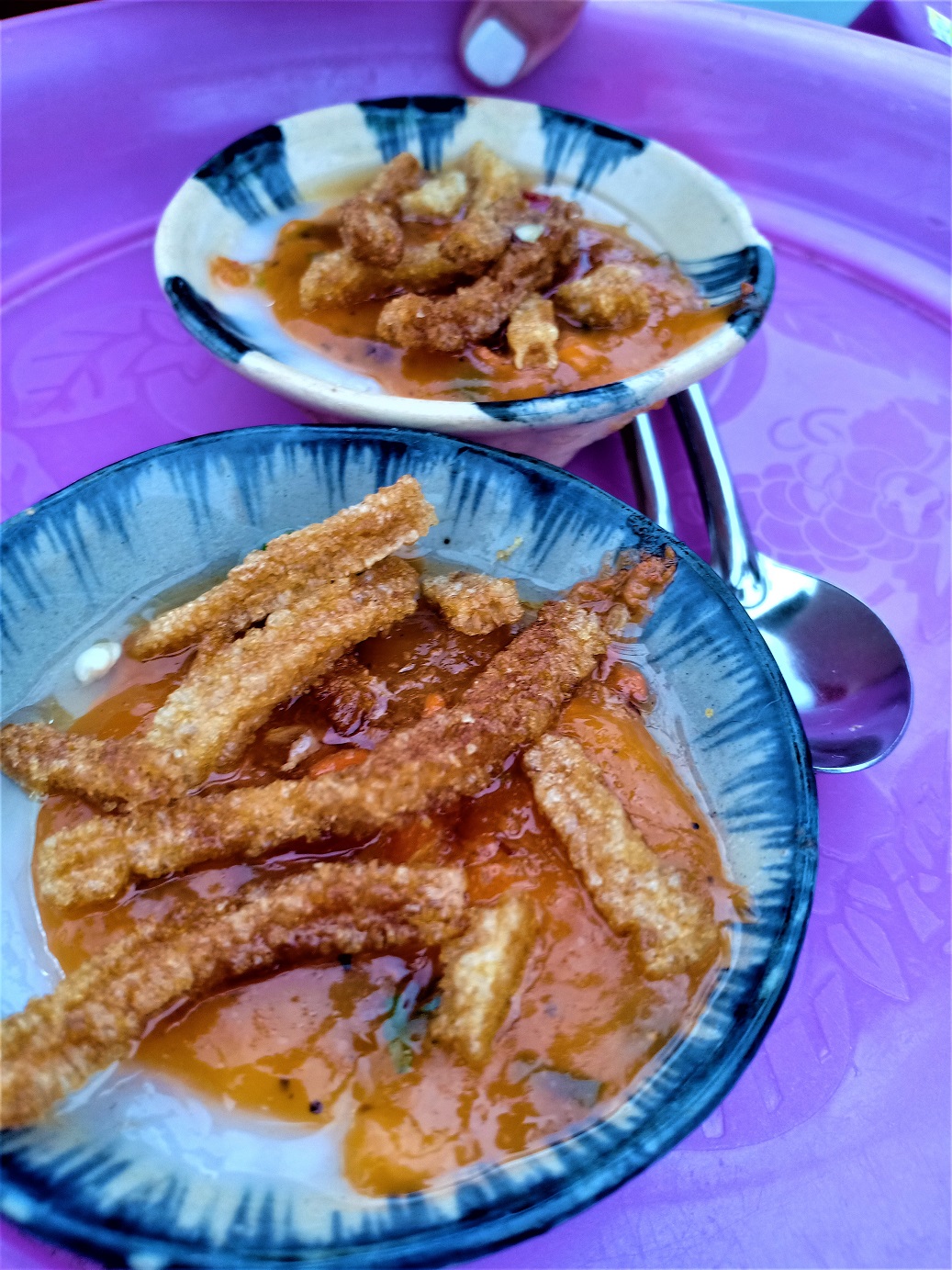
At first glance, I thought they are merely crackers served in a sauce dish. On closer inspection, I only then realised they are actually a dish on its own.
A Hue speciality, bánh bèo is made from chopped marinated shrimp and pork or ham, with rice flour and/or tapioca flour water added to the mixture to form a viscous “paste” and the past is finally cooked by steaming.
Topped with crispy pork skin or cracklings and served with a special peppery shrimp sauce, bánh bèo proved to be a very addictive snack or appetiser. The smooth rice cake that glides down and the crispy cracklings and toppings result in a very interesting gastronomic experience.
Where: Right next to the river along Bach Dang street, right opposite to the crowded grilled pork established “Anh”.
How much: 10,000VND per plate
5. Bánh bao bánh vạc aka “White Rose”
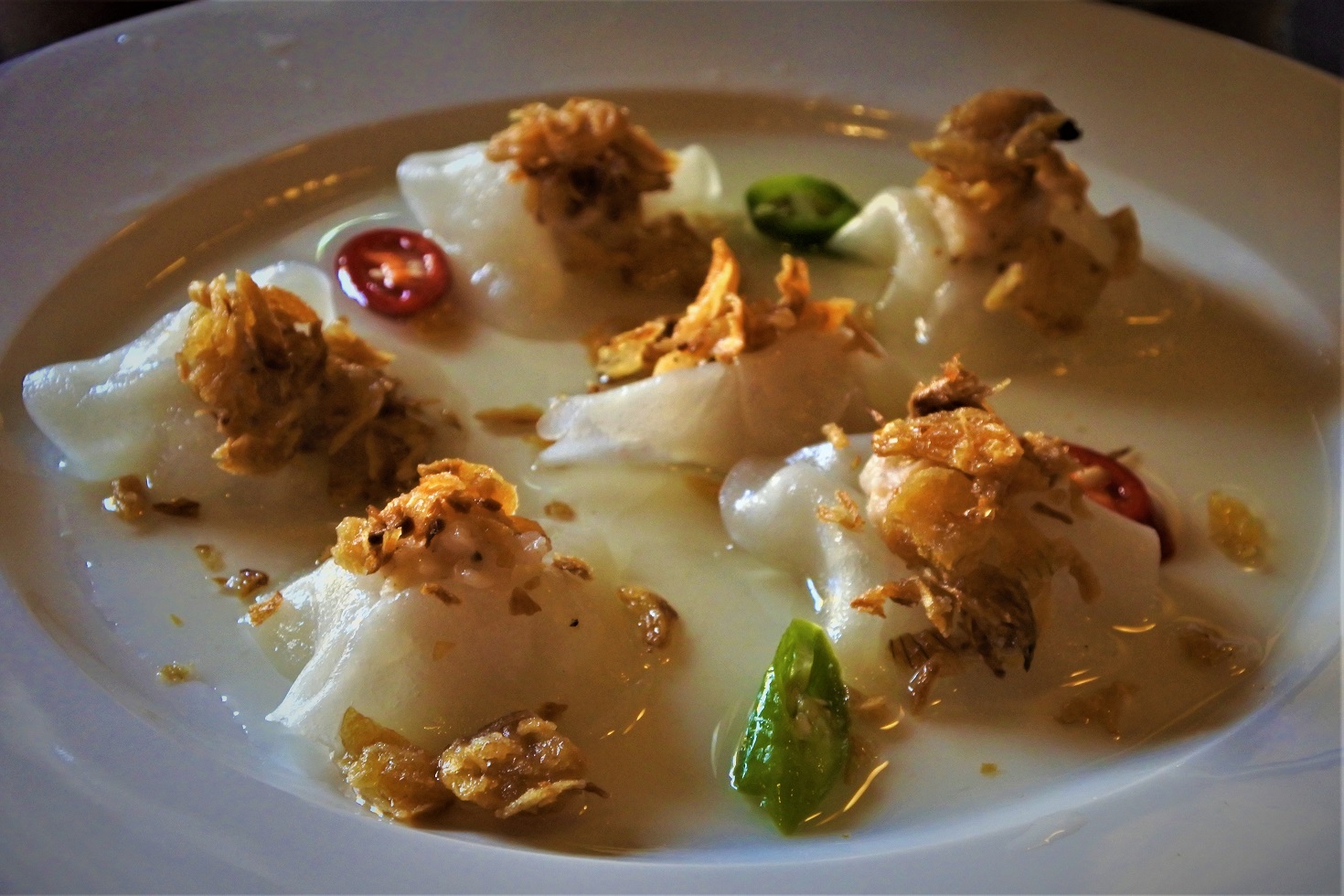
Folded to resemble white roses, these delicate dumplings are such beautiful, dainty morsels, akin to Christmas presents awaiting to be unboxed for one to reveal the surprises within.
The ingredients are not complicated: minced pork and shrimp, chopped mushroom and sometimes onions. The filling is then wrapped with a thin layer of skin made from glutinous rice flour and then cooked by steaming. The dumplings are usually served with a dipping sauce on the side or in my case the dumplings are doused in the sauce itself. The sauce is light and refreshing – sweet and tangy from fish sauce, sugar and lemon. The dumplings are lastly topped with crispy fried shallots and pickled chillies for extra crunch and flavour.
Do not underestimate the simple ingredients and seasoning, these dumplings were bursting with flavours and the smooth texture of the skin was a delight to the palate.
The skin was unbelievably thin, delicate and succulent. The filling was cooked to perfection, soft and tender. The seasoning of the dipping sauce was on-point, the sweetness and tanginess from the sauce made the dumplings even more scrumptious, aperitive and appetising.
As there were only 6 pieces of dumplings to be shared between the 4 of us, we indulged in our share of dumplings in small bites and thoroughly munched on each mouthful to fully enjoy its aroma and taste. The experience was divine.
Where: Miss Ly, 22 Nguyễn Huệ, Cẩm Châu, Hội An, Quảng Nam 560000.
How much: 70,000VND, varies depending on the restaurant.
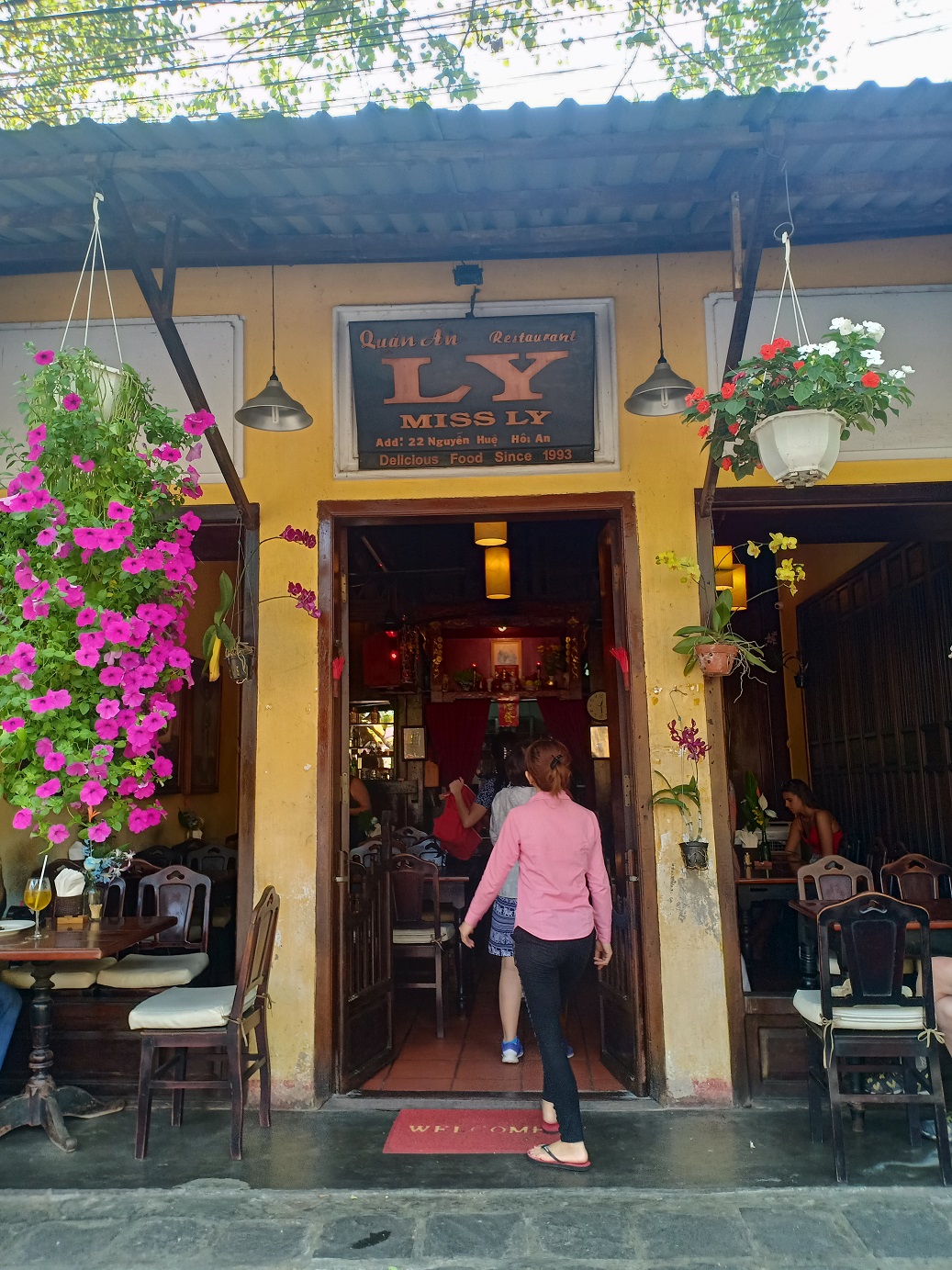
6. Cơm Gà Hội An (Hoi An Chicken Rice)
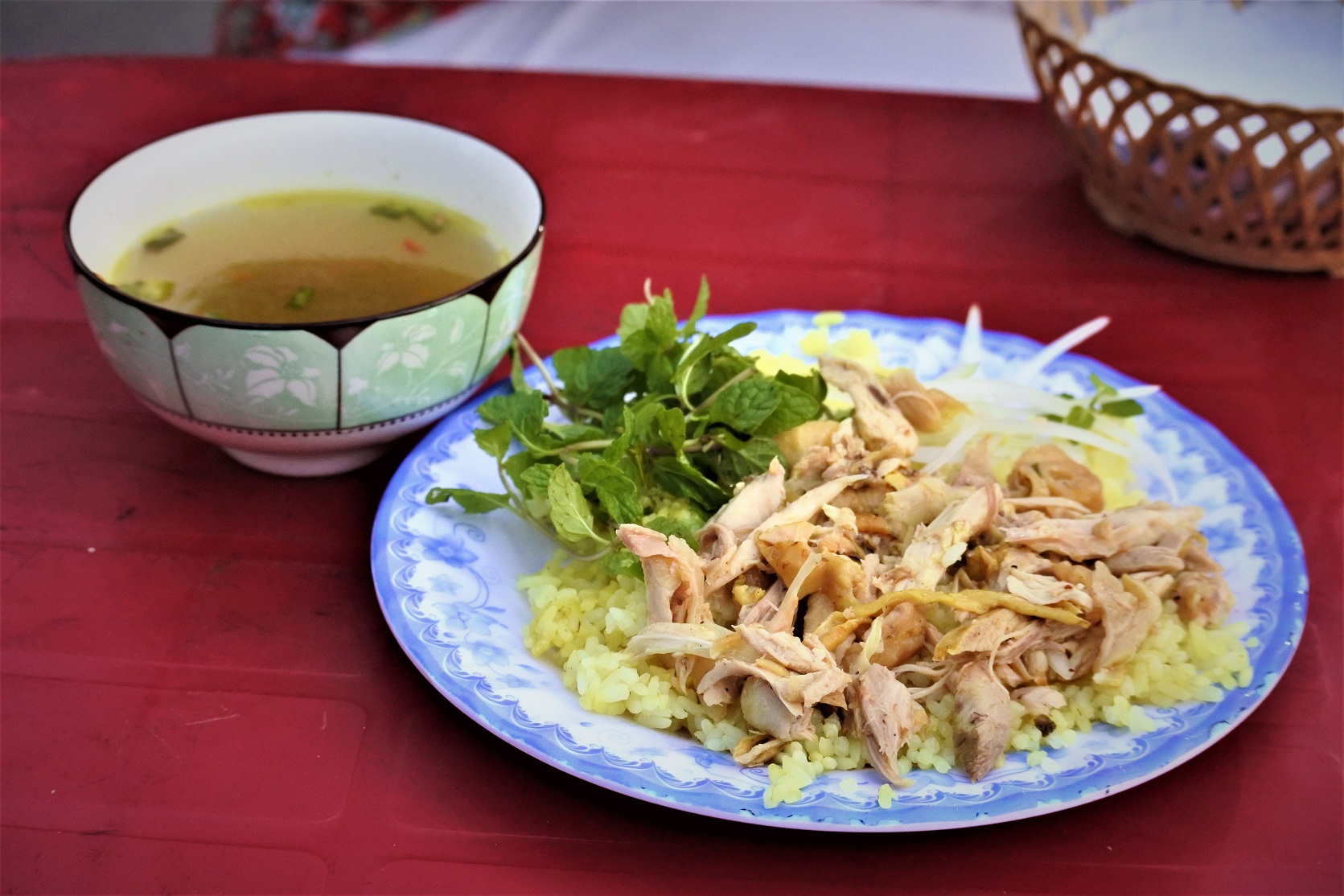
When we talk about chicken rice, we would normally think of the Malaysian or Singaporean version of chicken rice. But who knew Vietnam too has its own version of chicken rice.
Vietnamese chicken rice is quite different from what we, Malaysians, are used to. First of all, the colour of the rice is slightly more yellowish than the Malaysian chicken rice. I believe the rice gained its colours from turmeric, judging from their abundant use of turmeric in their cooking.
Another interesting characteristic I observed is that the chicken is deboned and shredded into fibres, mixed with thinly sliced raw onions and herbs and then served on top of the chicken rice. A bowl of chicken soup was also served along with the chicken rice.
Out of all things, the thing I liked the most is the soup. It’s sweet and delectable from the chicken oil and a nice peppery kick came through right at the end of my throat. Rice was fragrant enough but nothing was particularly special with the chicken itself.
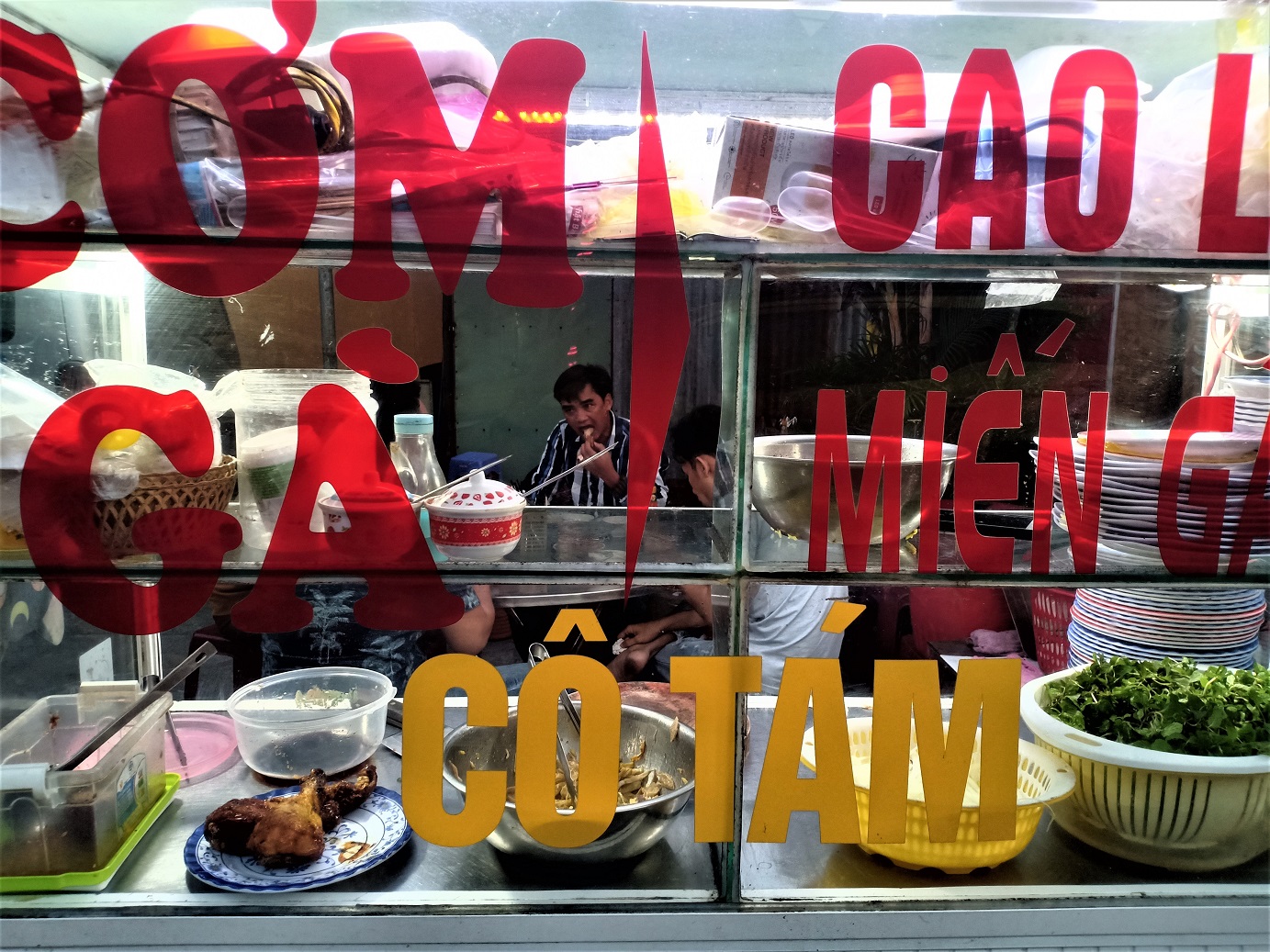
Where: Road side stall, can’t remember where.
How much: 30,000VND, depending on where you eat it.
7. Thịt Xiên Nướng (Vietnamese Grilled Pork with Rice Paper)

As we were walking along the river side around the vicinity of the old town, this particular establishment caught our eye. The restaurant was full of patrons, squeezed elbow-to-elbow, furiously tucking in their meals. I could even smell the aroma of the grilled meat from few streets away.
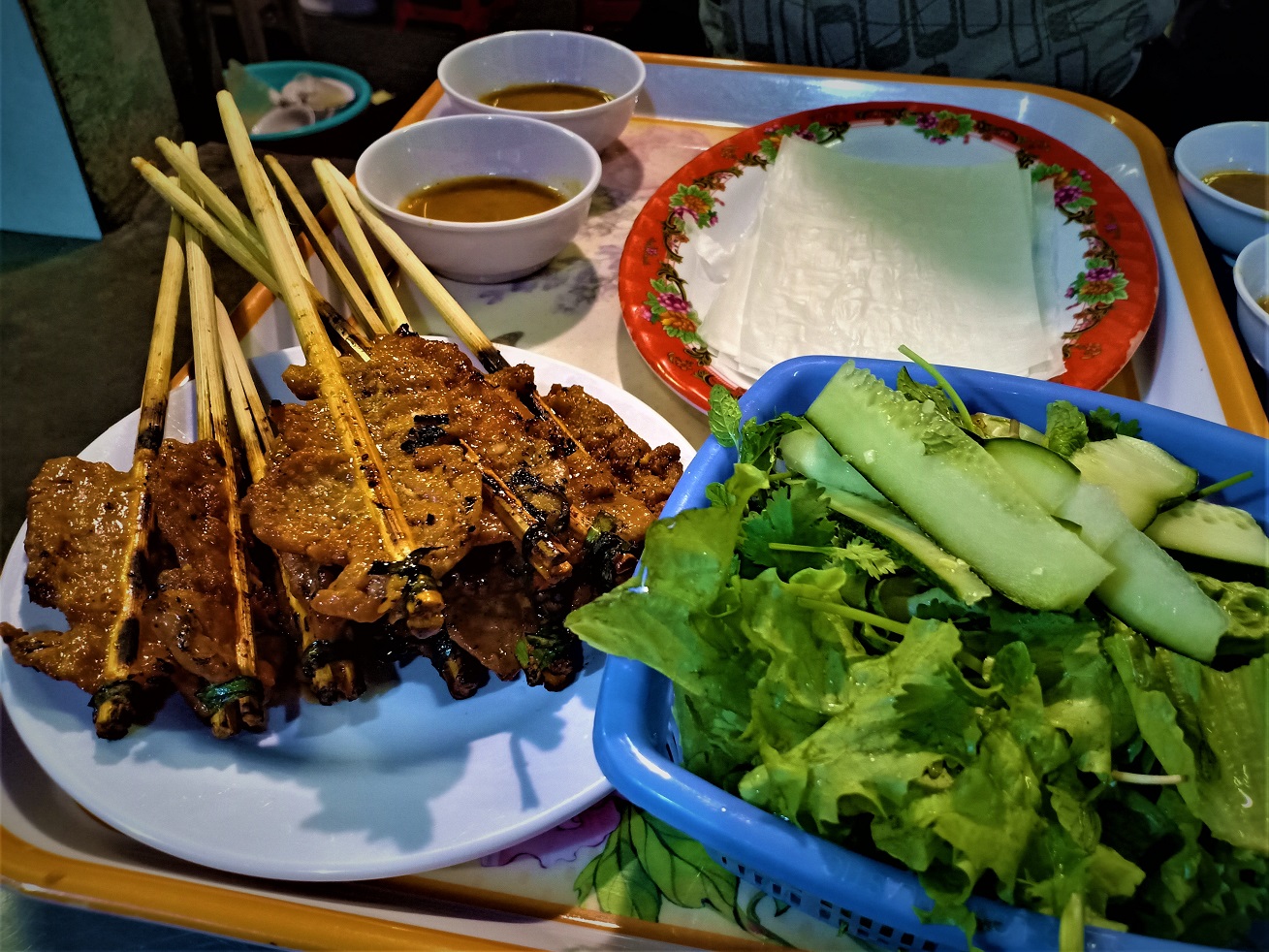
Based on the taste, I think the pork was marinated with turmeric, fish sauce, sugar, lemongrass, shallots and maybe some five spice powder. The marinated pork was then skewered with bamboo chopsticks and grilled until slightly charred. The pork was juicy and tender, coupled with fresh herbs and greens and wrapped in chewy rice paper, lastly dipped in the complimentary peanut dipping sauce, each bite was bursting with flavours.
It was a very hands-on dining experience as you had to loosen the pork pieces from the chopsticks and make your own individual wrap before you can tuck in.
To wash all of that pork greasiness down, there is a tiny stall right outside the restaurant from which you can order the Vietnamese sweet bean curd (Tào phớ) as an after-meal dessert. However, the bean curd is not as smooth as what we have in Malaysian taufufah (also a similar bean curd dessert).
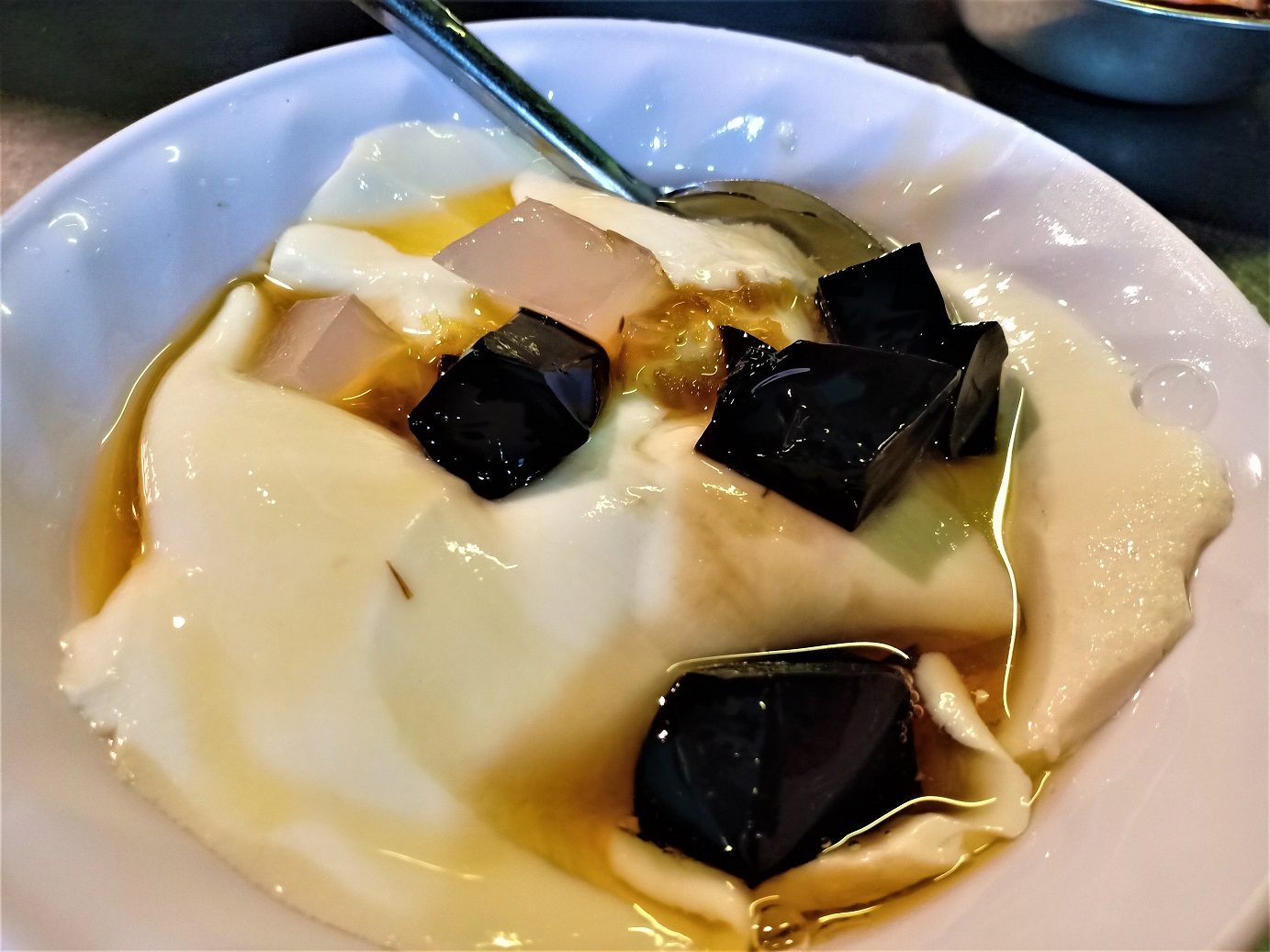

Where: Right beside the river along Bach Dang street, see signboard in above picture.
How much: 240,000VND for one whole set of grilled pork + 2 bowls of bean curd dessert.
8. Cháo (Vietnamese Rice Porridge)

We were wandering aimlessly looking for breakfast on a quiet Saturday morning, until we came across a few old ladies hanging out by the roadside squatting on tiny plastic stools having breakfast. Out of curiosity, we went to have a closer look at what they were eating.
Oh, it’s some red, brown-ish rice porridge! Feeling like having something light for breakfast, we ordered two bowls of porridge to share. The porridge came with toppings of braised tofu, onions and long beans. Although it was such a simple dish, it was the braised toppings that shone through. Warm, hearty and wholesome, I highly recommend this to anyone looking for a light breakfast.
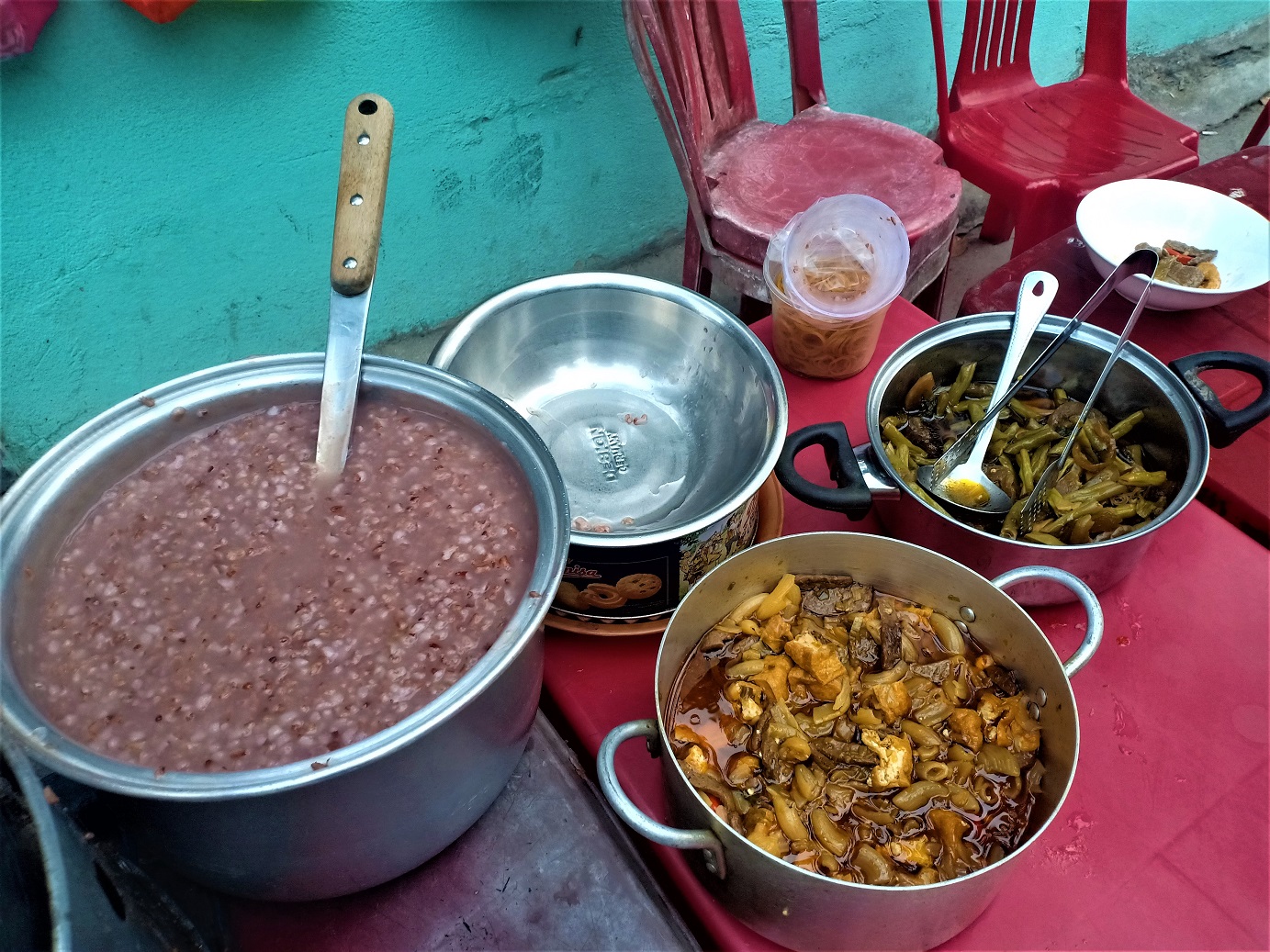
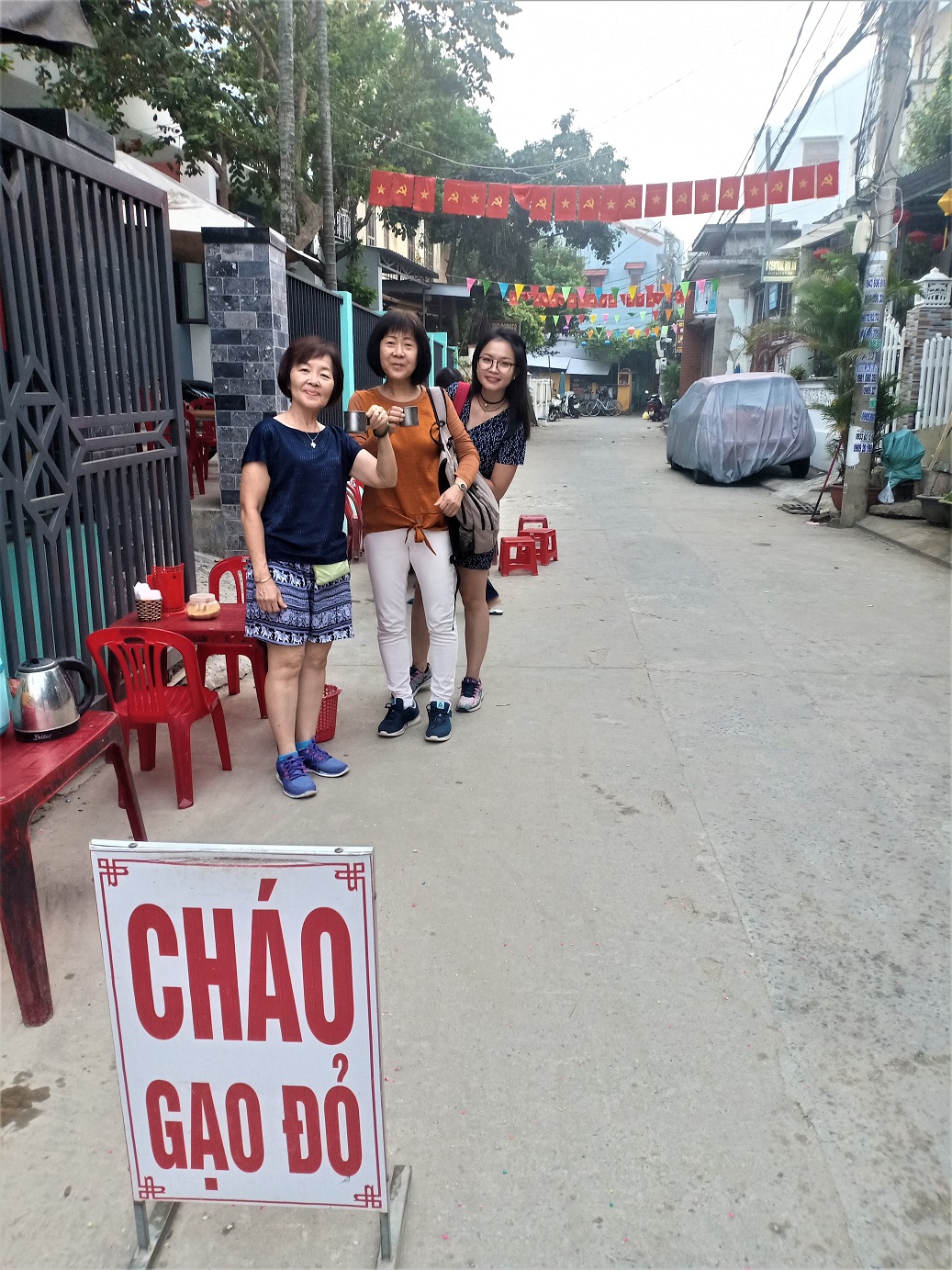
Where: Some local neighbourhood in Minh Ah part of Hoi An (Sorry guys)
How much: 10,000VND (We were so grateful that the old lady charged us local rates, loving her honesty :))
9. Bún đậu mắm tôm (Vietnamese fermented shrimp paste)
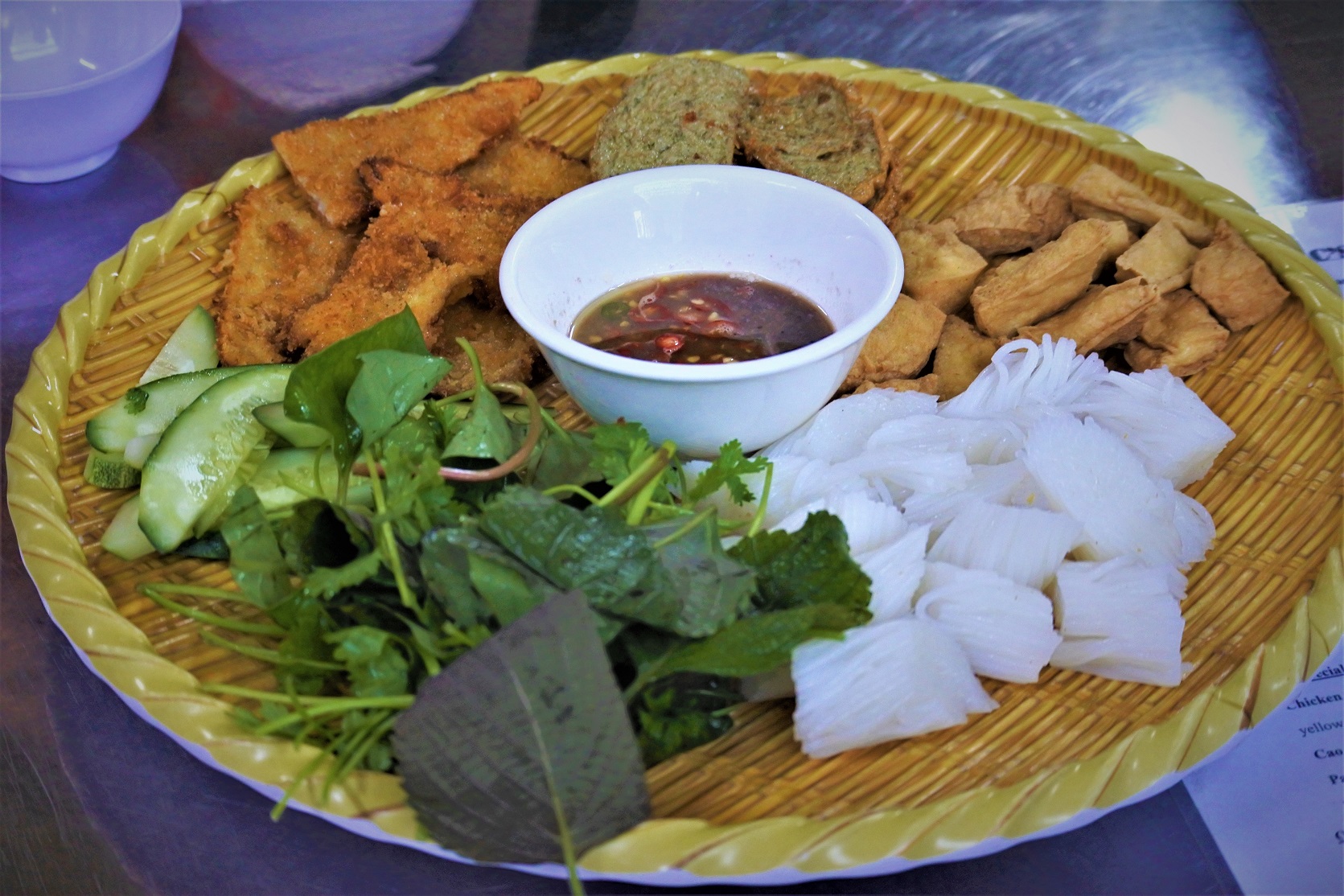
This establishment is actually quite a walk away from the Old Town, but it was worth every kilometre that we had covered on foot to get there.
Bun Dau typically consists of rice vermicelli, deep fried tofu and some other meats, fresh herbs and greens and last but not least the shrimp paste, which is the star of the dish. Do not let the term “fermented shrimp paste” to scare you off from trying the dish, though.
A good Bun Dau sauce should not be too thick or salty and is nicely seasoned with kumquat or lime, so you get a perfectly balance of tanginess, sweetness and saltiness. The sauce does its job in cutting through the greasiness of the deep fried food items. The fried tofu and meats were fried to golden perfection, crispy on the outside, soft and moist on the inside.
How to eat it? There’s no specific way of eating it – you could either dip the individual item in the sauce and just eat it on its own, or combine a little bit of the rice vermicelli and fried tofu wrap them in a piece of lettuce leaf and dip them in the sauce.
Where: Quán Dâu Bắc – Bún Đậu Mắm Tôm, 71 Đào Duy Từ, Phường Cẩm Phổ, Hội An, Quảng Nam, Vietnam
How much: Depending on the set or food item that you order, ranging from around 80,000-150,000VND

10. Bánh mì
One of the most iconic if not, the most popular food in Vietnamese cuisine, you could probably find Banh mi anywhere in Vietnam, in fact, in most major cities in the world.
This particular Banh mi that we sampled was very generous with its fillings. Packed with pate, roast meats, cucumbers, lettuce, tomatoes, meat mince, and a plethora of tomato and meat sauces, biting through its crispy baguette and sinking our teeth into the many layers of ingredients was particularly satiating.
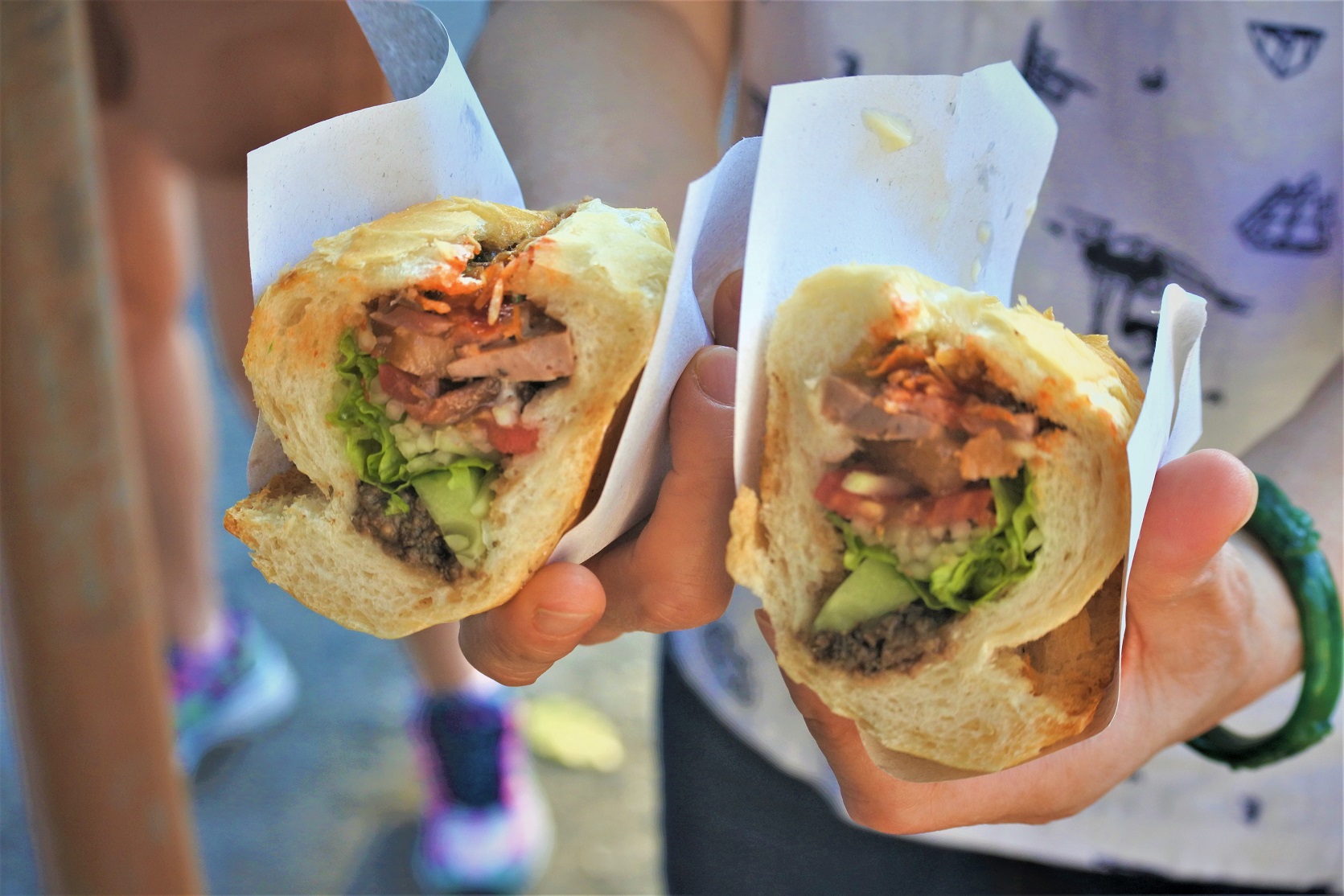


Where: One of the road side stalls along Nguyen Hoang street, right where the Hoi An night market is.
How much: Around 20,000VND per sandwich.
11. Mít Trộn (Young Jackfruit Salad)
This is perhaps the most interesting, if not the most peculiar, street food that we had ever encountered throughout our Vietnam trip.
This salad consists of young, unripe Jackfruit, crushed peanuts, some ingredient with cartilage-y texture (which I believe is pig’s ears), crushed peanuts, some chilli paste, basil leaves, and rice crackers.
How did we discover this local street food? We were walking around the Hoi An night market and we saw one of the local stall vendors was having his dinner. Out of curiosity, I had a peek at what he was eating, it was something I had never seen before in Vietnam so far.
I asked him in simple English where did he buy it from, he pointed to an old man on bicycle not far away from us. At first, I couldn’t understand what he said and was looking for a food stall selling this but we couldn’t find it. In the end, we managed to locate the old man with a bicycle to which a big mixing bowl and few plastic containers were attached. We couldn’t actually make out the ingredients even when we were eating it. The young unripe Jackfruit had a very crunchy texture to which I thought were bamboo shoots initially.
Overall, it was an interesting and somewhat healthy snack which goes really well with the crispy sesame rice crackers.
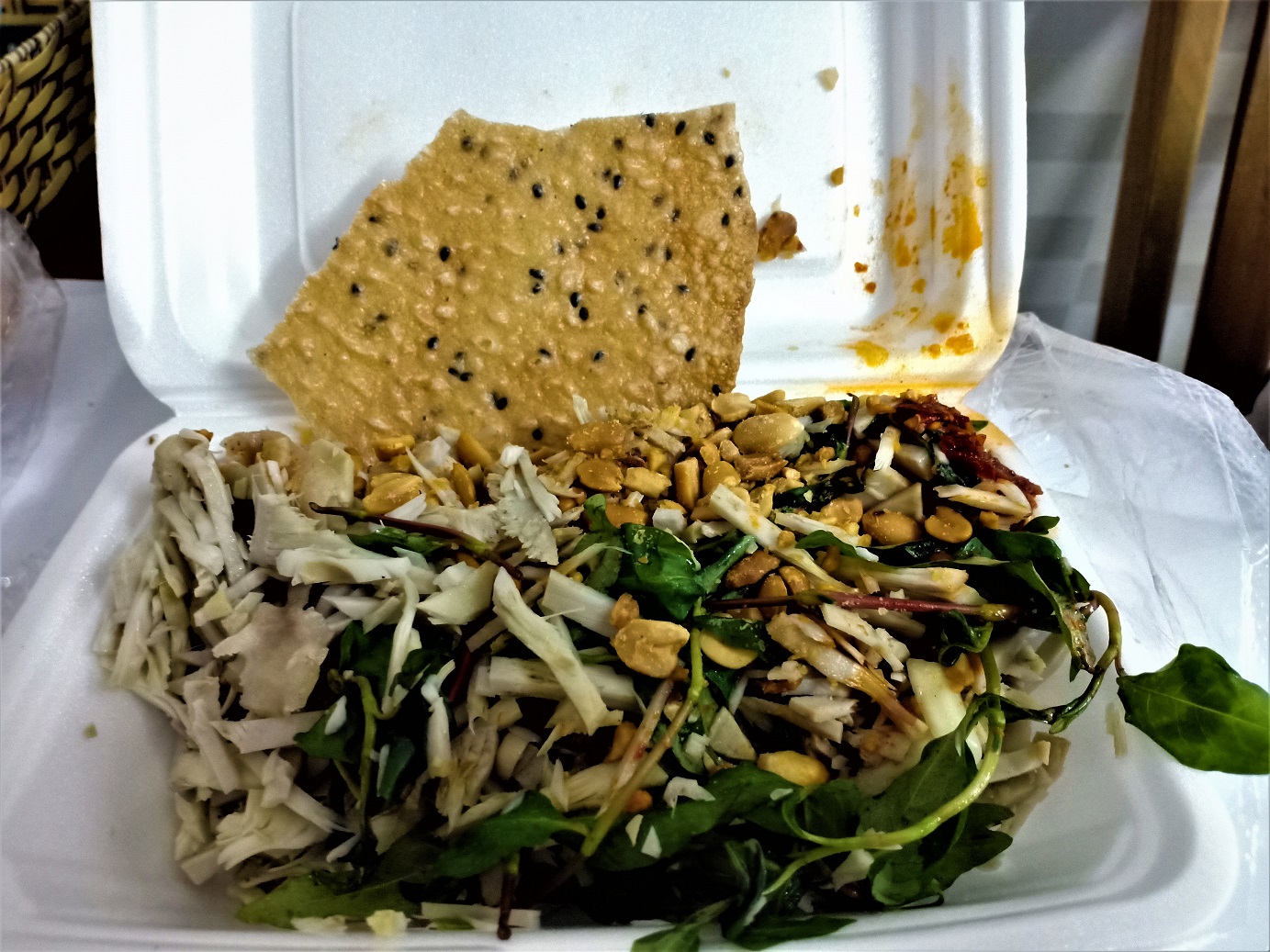
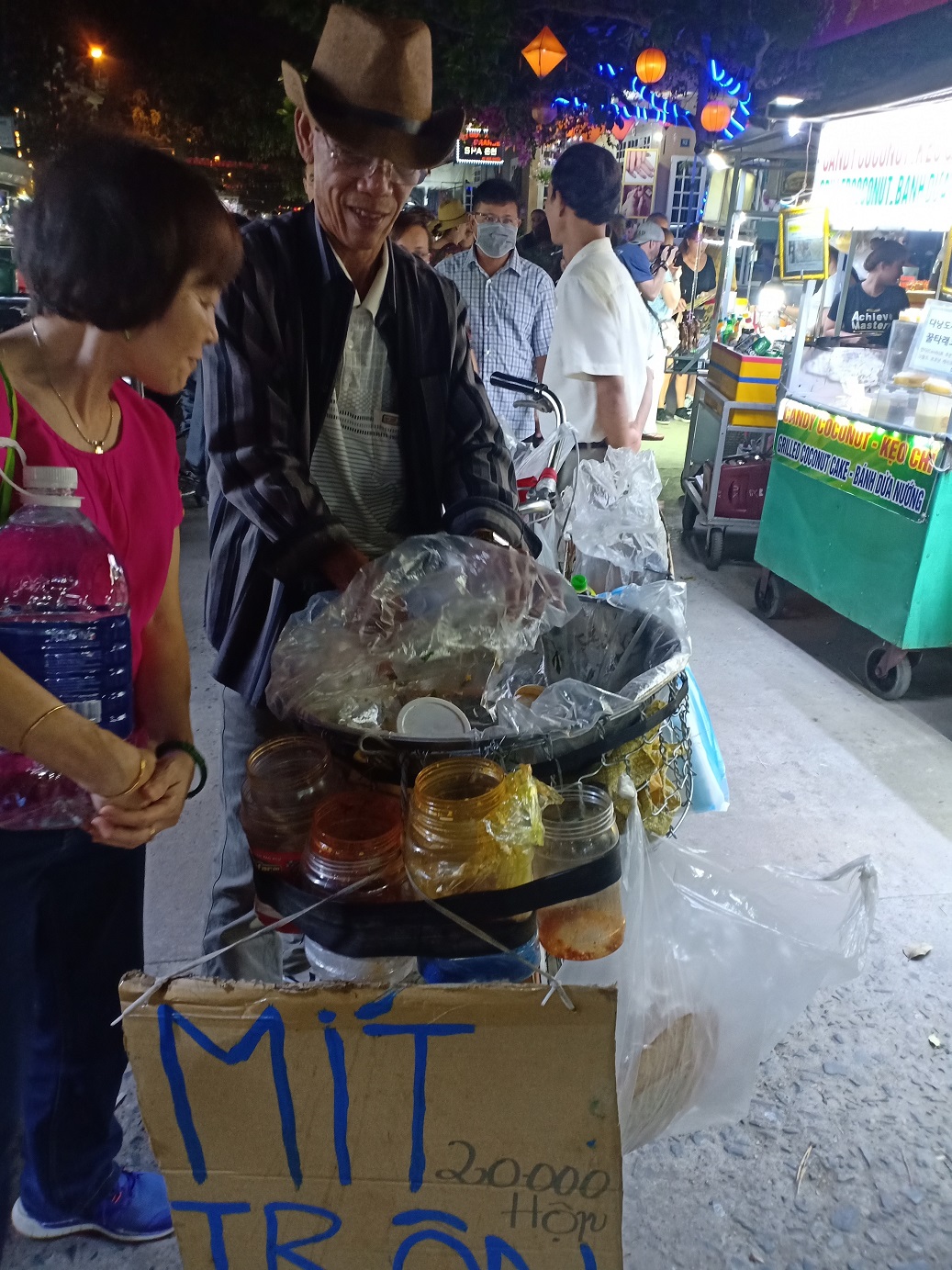
Where: Within the vicinity of Hoi An night market, the old man selling it moves around on his bicycle (pictured above)
How much: 20,000VND per pack
12. Bánh cuốn (Vietnamese Steamed Rice Rolls)
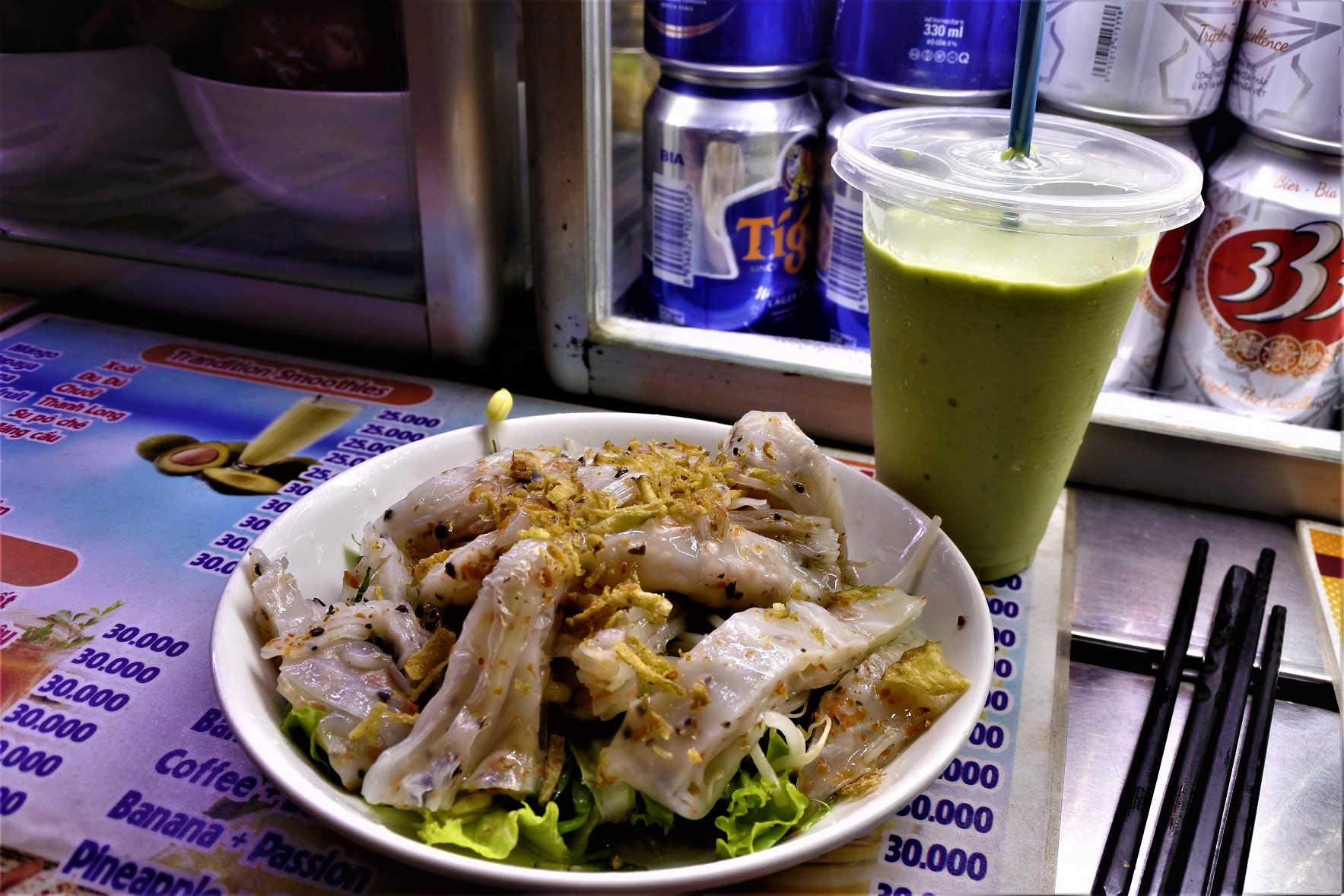
I would never forget that we had one of the best avocado smoothies inside the Hoi An Central Market.
The lady stall owner was very generous with the avocados and milk, no ice was added into the blender. The result? Unbelievably thick, smooth, creamy, cold and refreshing. It was literally the crème de la crème of avocado smoothies. This time round, all four of us each ordered a cup for our own indulgence, no sharing for this heavenly smoothie!
Ok, back to the rice rolls. Banh cuon originates from northern part of Vietnam but can be found in most parts of Vietnam as it is such a simple and delicious delicacy. Made from rice flour and starch, this version of Banh cuon that we had was served had diced wood ear mushroom, carrots and some pork mince in the rice rolls. Topped with crispy fried shallots, they were doused in a sweet and savoury sauce. Not the best version that I had, but it was good enough for us to call it a satisfying meal, especially when we got to down it with the yummylicious avocado smoothie.
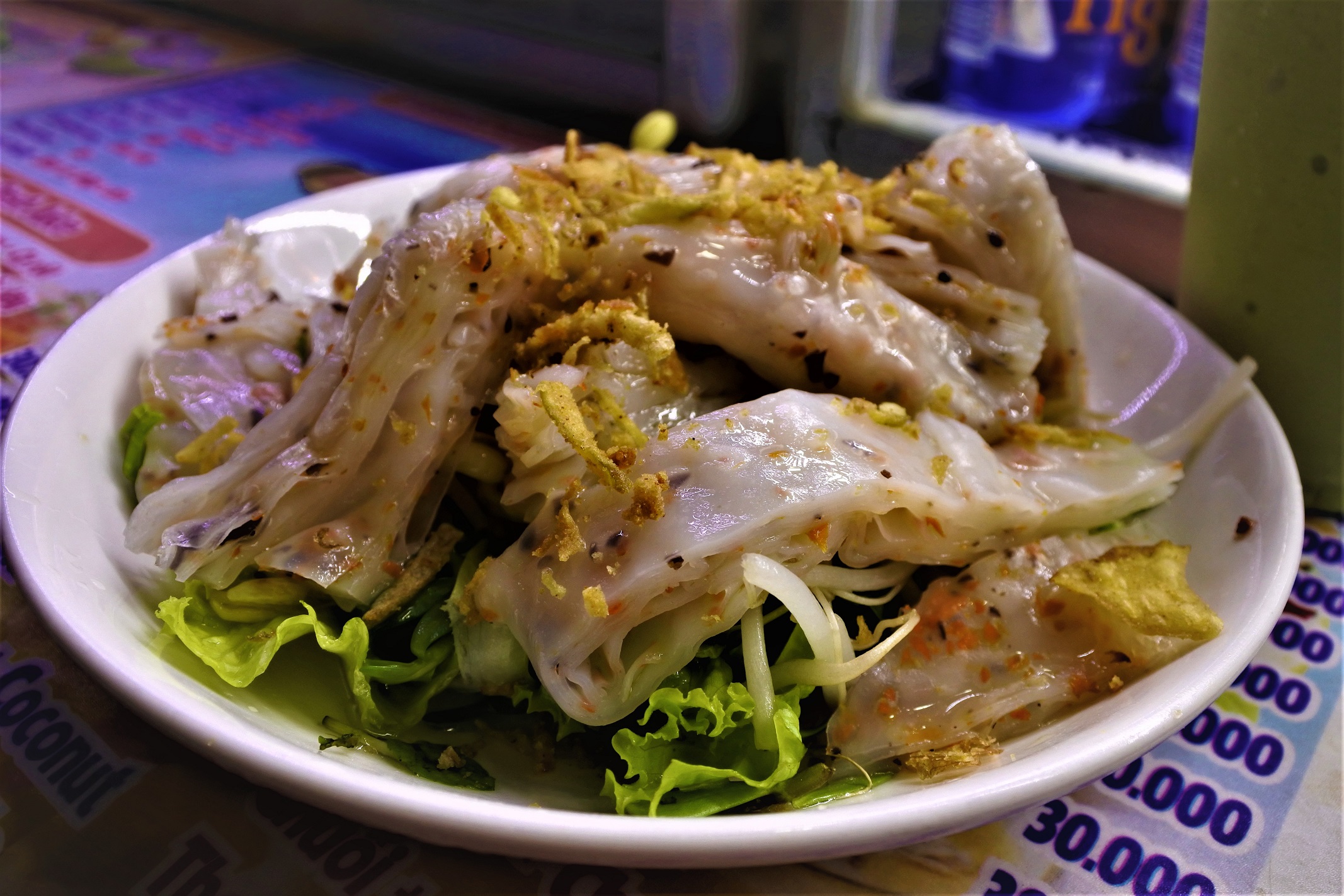
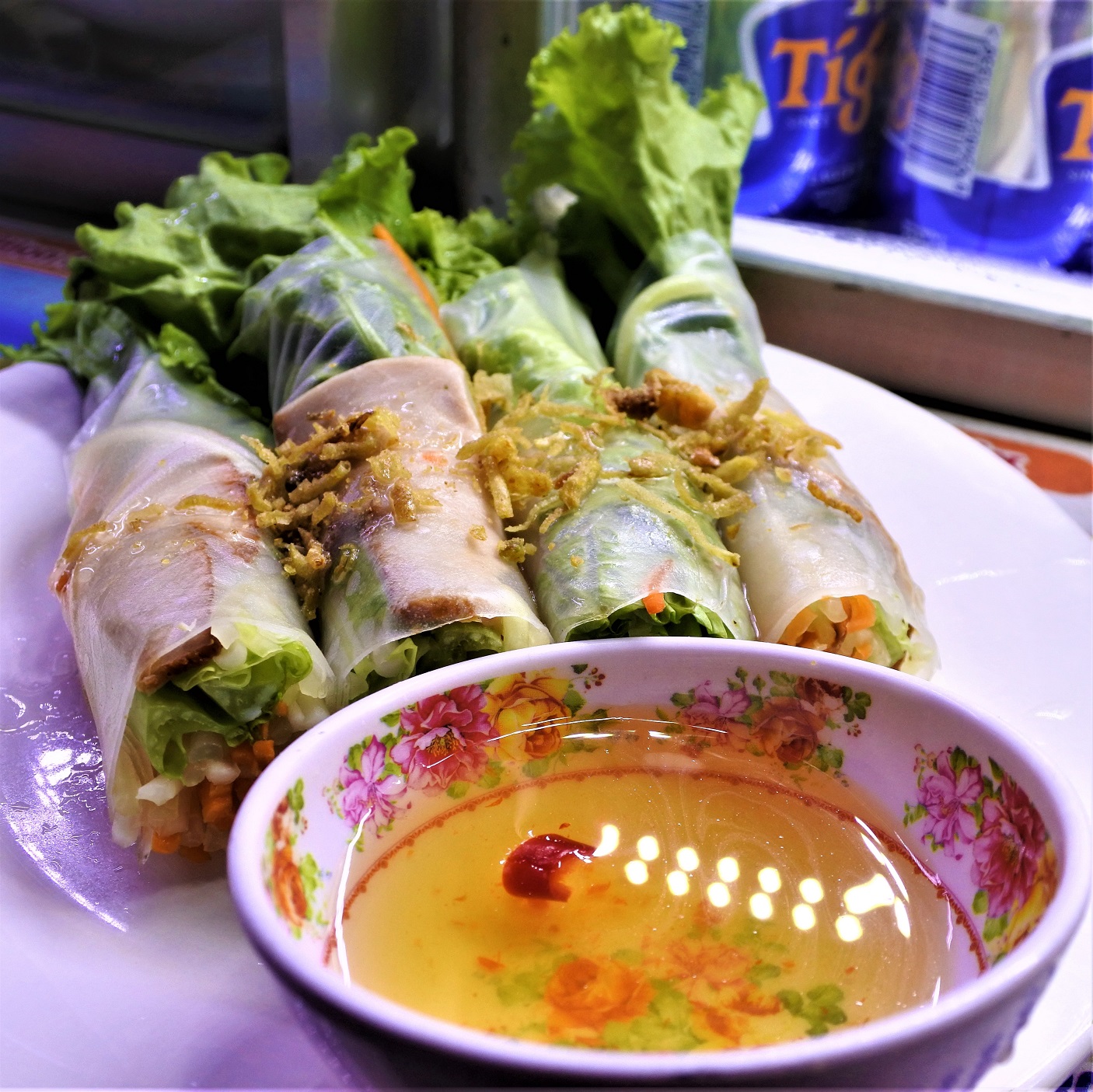
Where: Hoi An Central Market, 73 Phan Bội Châu Sơn Phong tp. Hội An Sơn
How much: Avocado smoothie – 30,000VND per cup; Banh cuon and spring rolls – 30,000VND each
A word of caution, vendors inside the Central Market can be quite aggressive. We came across a lady vendor who welcomed us to the market when we were finding a spot to park our bicycles. As we entered the market, she asked us to buy the food from her stall, but we were discouraged from buying from her stall because the food was lying around in the open and did not appear to be hygienic. So, we went to look for food from the other nearby stalls. She got really angry and started shouting at us and at the avocado smoothie vendor from which we bought the avocado smoothies. Although we couldn’t understand what they were talking about, but based on the tone, we could sorta of guessed the former lady vendor was pretty angry at the avocado smoothie vendor for “stealing” her customers from her. The arguments didn’t stop until after we finished our meals and left the market hurriedly. To be honest, it kind of ruined our dining experience there.
Afterthoughts
Whenever I travel, I’m always on the look out for local, authentic street food or delicacies which I have never tried before. I’m always curious and wanting to find out what the local people eat, as that’s one of the ways to interact with them and to also experience local culture through food.
So, one way to discover local food is to be inquisitive and never be afraid of asking what the locals are eating. A hole-in-the-wall establishment or even a road side stall with few plastic tables and stools but packed with local customers is always a good indicator that they serve good food.
Anyway, till we can travel again, let’s stay safe and keep well. Never let the wanderlust spirit in us subside!





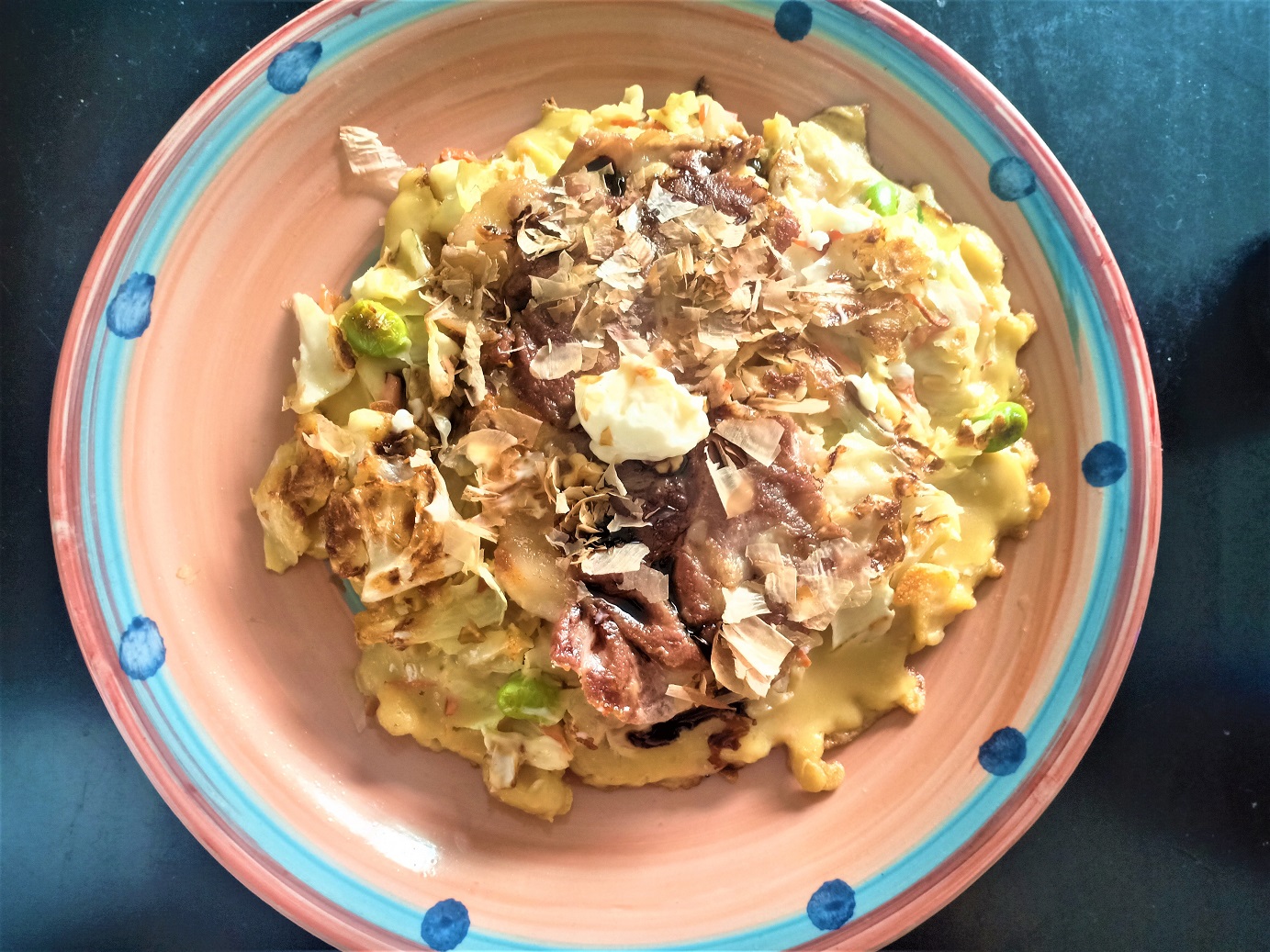




Pingback:Food Guide - What I Ate (& Drank) in Danang, Vietnam - foodieadie